 |
[September 6th, 2004]
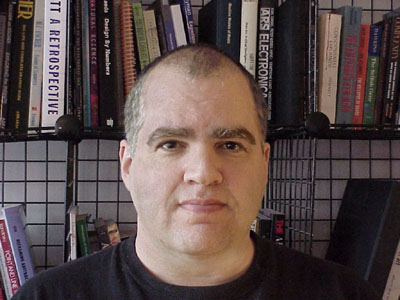
Philip Galanter.
'Generative art is as old as art'. An interview with Philip Galanter
In discussions of generative art, Philip Galanter's definition pops up more than often:
'Generative art refers to any art practice where the artist uses a system, such as a set of natural language rules, a computer program, a machine, or other procedural invention, which is set into motion with some degree of autonomy contributing to or resulting in a completed work of art'. (From 'What is Generative Art? Complexity Theory as a Context for Art Theory'). Some of the consequences of this definition are the inclusions of non-digital works and numerous historical art forms into the category of generative art. Thomas Petersen and Kristine Ploug asked Philip some questions, setting out to dig deeper into some of the aspects of the definition and his own artistic work in the field.
Philip Galanter is currently the Associate Director for Arts Technology at NYU's Information Technology Services and Adjunct Professor at the Interactive Telecommunications Program. He is an artist working with physical generative systems, analog and digital video, digital fine art prints, and installations. For more information check out: http://www.philipgalanter.com.
Images courtesy of the artist.
We'd like to start by asking about your work with generative art in general. Tell our readers a bit about your activities.
First I'd like to thank you and your net publication not only for your interest in my work, but also for your coverage of the field of generative art as well.
I've been working in various forms of generative art since entering college in 1971. Of course back then I didn't think of it as generative art. The term hadn't been invented yet. But I was very excited by the then relatively new realm of voltage controlled music synthesizers...the Moog, Arp, and so on. Most synthesizers were played with a piano-like keyboard. Sometimes they were used with a sequencer so playing musical phrases could be automated ... not unlike a player piano. But properly configured such a synthesizer could, in effect, also generate surprise by using noise sources, sample and hold modules, and so on. I found the notion of an instrument that was constantly creative to be very exciting indeed.
Randomization seems to be a phase that all generative artists have to go through!
At the same time I was teaching myself computer programming and did some experiments with the very basic graphics technologies available then, again trying to create systems that would self-compose and surprise even me, the nominal creator. In terms of my formal studies, however, I started out in Physics but ended up getting my B.A. in Philosophy. After college I did a lot of work in non-generative music ... punk bands, industrial and experimental projects, electronic music and software creation, and very odd performance events. It was a simultaneously torturous and fulfilling time.
But for about the last 15 years I've been working in generative forms again. Even though for various reasons I wanted to work alone rather than collaboratively, I missed the surprise factor of working with others. Working in generative forms restores the surprise factor to some extent. But more and more I've gone beyond that as a motivation, and increasingly working with generative systems is more like experimental philosophy. Philosophy via experimental means.
The generative systems we create as artists are far simpler than the systems we encounter in everyday life. But by creating these comparatively minimal systems we can discover truths about the world that might otherwise be masked by the relative chaos of the day to day. In my own generative work I like to say that I am moving from nouns to verbs. My earlier work was about using systems to create art objects. At first abstract videos using analog feedback. Later digital prints and digital video installations using genetic algorithms, Markov-like processes, L-Systems, reaction-diffusion systems and so on. From the point of view of the audience, however, the generative process was over by the time the work was presented.
It was as if I was showing animal skeletons or dinosaur bones and asking the audience to imagine what it was like when these creatures were walking the earth. Now I am trying to create systems that reveal themselves as processes before the audience. Metaphorically, I want to show living breathing animals and not just bones. The artwork should be the generative process not the trace the generative process leaves behind. Verbs not nouns.
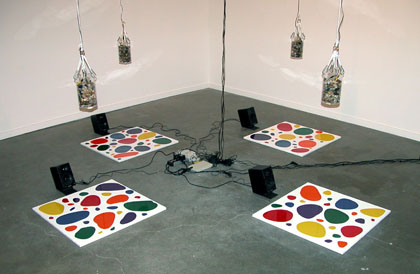
Philip Galanter: Chaotic Conductor. Read the artist's statement here: http://www.artificial.dk/articles/chaotic_conductor.pdf.
The idea of putting the art making process in the place of a pre-generated artwork is of course a key element in much generative art. One might make the assumption that generative art has grown out of a process-oriented aesthetic based on a twentieth century avant-garde practice. Would 'the art making process as the art work' not have been impossible without these art historical conditions?
In a very real sense art never goes away. It is a process of accretion, a layering of new ideas upon old ideas, creating an ever evolving mass. The old art is always with us even if it is hidden deep inside the newest art.
There is a very specific historical movement called 'process art' which involved the use of flexible or chemical materials, sometimes poured plastics or fiberglass. The artist would indeed give up some control and accept what the material would dynamically reveal itself to be. Generative art has a fuzzy border, and process art is near that border, some on one side, some on the other. Someday soon I hope there will be a second wave of process art. Imagine having buckets full of nano-machines. Splash them on a wall and they slowly etch patterns creating a mural. Or pour them on the floor, or perhaps add sand particles, and they self-organize creating sculptures. And perhaps these murals and sculptures 'stay alive' and are constantly changing.
Generative art didn't start with computers, and I don't think it will end there either.
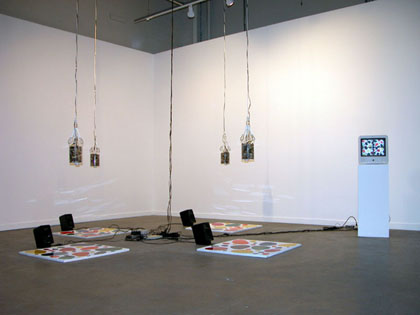
Philip Galanter: Chaotic Conductor. Read the artist's statement here: http://www.artificial.dk/articles/chaotic_conductor.pdf.
Tell us about a generative work, which has had special meaning for you, and which points out an interesting direction for generative art?
It's hard to pick out just one. I know on your site you have a picture of Hans Haacke's piece 'Condensation Cube'. It's a work I also included in a show I curated with Ellen K Levy called 'Complexity'. It is simple and elegant. A plexiglass cube is sealed with just a bit of water in the bottom. Tiny variations in temperature and surrounding air currents result in a constant cycle of evaporation and condensation patterns on the walls of the cube. The cube is, in effect, a weather system in a box. This work entirely anticipates everything we now know about complex systems and chaos. In fact at about the same time Haacke did this piece Ralph Lorenz, a meteorologist, was discovering the strange attractor and the intrinsic unpredictability of weather systems.
And of course I always have to give a tip of the hat to John Cage. His use of the I Ching and other randomization methods to write music has inspired several generations of composers. The Zen inspired impulse to hear the value of sounds as they are rather than as we wish them to be is a very important lesson both about art and life in general.
But the most exciting generative work I've encountered in the past few years is by an artist we will never know. Most folks know about the prehistoric cave paintings found in France and elsewhere depicting animals and so on. The oldest of those is about 35,000 years old. But in 1999 anthropologists discovered the oldest known artwork, and this work is more than 70,000 years old. It consists of triangular tiles inscribed in hand sized pieces of red ochre. It is an exploration of pattern and esthetic form that would be clearly recognized as such by someone like M. C. Escher or generations of Islamic artists. And it is generative in that an abstract autonomous system creates the form rather than the moment to moment intuition of the artist. Tiling systems are algorithms that existed long before there were computers.
As I like to say, generative art is as old as art.
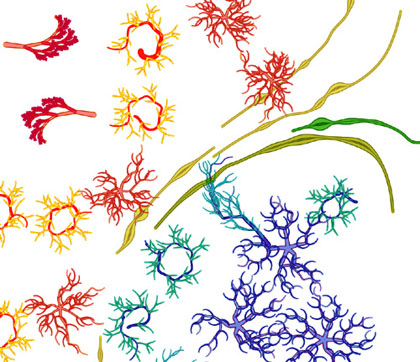
A detail from V091148 - Untitled Self-organized Drawing by Philip Galanter.
It seems that you understand generative art as all art based on systems, digital or non-digital, current or ancient. Does this not have the effect of encompassing too much, especially when you deal with ancient art forms? Isn't it important to remember autonomy as an equally important defining feature in generative art, and would this feature not exclude many historic (and quite static) art forms?
I know some artists emphasize the autonomous aspect of generative systems. The conceptual problem I have with that is that it's too easy to slip into comfortable postmodern/post-structuralist dogma about the death of the au thor and so on. For me the combination of complexity theory and generative art practice is, in fact, a corrective and partial antidote to the excesses of postmodernism.
But yes, of course, by definition generative art involves the artist releasing control to an external system. In my view, however, this is actually yet another reason to consider various ancient art forms as generative. Keep in mind, first of all, that the notion of the individual heroic expressive artist is a relatively recent and western idea. The vast majority of art worldwide is not about individual expression, but serves more as a sort of cultural glue and shared memory system. Art is one of the ways that cultures maintain and propagate themselves into the future. From this point of view the autonomy of systems for tiling, weaving, decoration, border patterns and so on is a strong survival adaptation. The culture survives even as individual artists come and go.
In addition, before the industrial age people had to manually execute the work we now trust to machines. Generative methods, such as tiling patterns, allowed a designer to utilize less expressive artisans to get the job done. It is exactly the self-contained autonomy of tiling patterns that allows the head architect or fabric designer to not worry about handing off the work. In pre-industrial times this was a great practical advantage offered by generative methods.
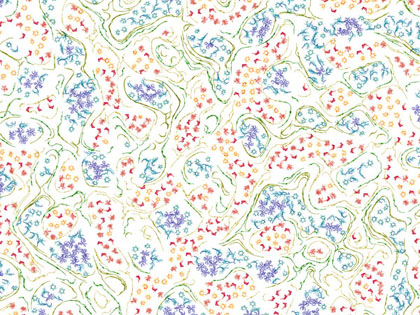
A full (low resolution) view of V091148 - Untitled Self-organized Drawing by Philip Galanter.
Your definition of generative art in the article 'What is Generative Art, Complexity Theory as a Context for Art Theory' does not link generative art with any particular technology. Generative art works may therefore be non-digital, organic and so forth. Do you think this inclusion of non-digital works into the category of 'generative art' has happened in retrospect after generativity has manifested itself as a specific trend within digital art?
Well, just as a matter of historical sequence it is certainly true that I personally started thinking about generative art in the broadest sense only after first pursuing specific generative methods. But even in my case digital art didn't come first. Analog systems such as music synthesizers and video feedback did. But there is no doubt that digital technology gives generative artists unprecedented leverage in creating and exploring systems. The tradeoff is that you end up creating these systems in the tidy virtual world of the computer and not the compelling physical visceral world where we live our messy emotional or spiritual lives.
Ultimately though what differentiates generative art from other kinds of art is the use of systems. And this is where new notions from complexity science can give us some critical insight. Some systems are highly ordered, like the tiling systems first explored by our prehistoric artist some 70,000 years ago. Other systems are highly disordered, like the randomized systems of John Cage. But both are, in their own way, quite simple. For generative artists today the real action is the complex in-between realm of partial order and partial disorder. That is where, for example, life itself exists. Haacke's 'Condensation Cube' hints at this, as does the interest of some artists in A-Life. But there is much much more work to be done. And thank goodness for that!
When discussing complex or simple systems as a part of the discussion of generative art works, it often seems that complexity is used as a criterion of quality. Don't generative artists also have some work to do in the conceptual department (Hans Haacke's Condensation Cube being the example of a successful piece)?
Oh, I agree with this and might even push the point further. First I'd say that complexity as a topic is no guarantee of quality. At this point in history it is certainly the right question to address. But some explorations are going to be more useful than others.
70,000 years ago our prehistoric friend exploring highly ordered systems via triangular grids was doing state of the art work. When John Cage explored highly disordered systems via randomization his work was absolutely critical to the evolution of sound art. But now tiling systems are fully integrated into most known cultures. And at the risk of upsetting some young electronic musicians out there, I am not so sure the world needs much more random number generator music. It has its place, but I don't think any new conceptual ground is being covered. At least with complexity you know you are entering relatively virgin territory.
But second, I think it's important to note that just because a work is exploring complexity as a topic that doesn't mean the piece itself has to be complex in the everyday sense of the word. My own bias is that complexity art may well reinvigorate minimalist values. After all minimalism was never about making a minimum of art, it was about making maximal art with minimal means. It's not surprising that it lead to conceptual art because the stripped down nature of minimalism demanded precision, clarity, and focus to succeed.
It's tempting to address complexity with complicated technology, but all too often the point is lost in a gaudy fetishistic spectacle. In my work, such as the recent 'Chaotic Conductor' I am using relatively simple technology that allows the audience to have an intuitive, first hand, visceral experience. A maximal concept via minimal means.
More:
- Our special on generative art.
|
 |
|